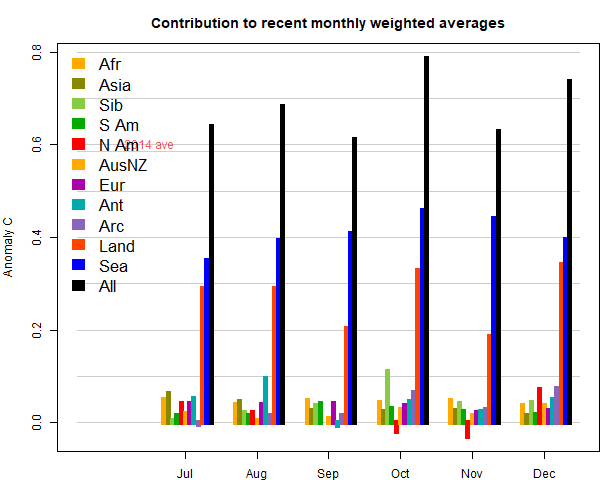The GISS land/ocean temperature anomaly fell 0.21°C last month. The November anomaly average was 0.77°C, down from October 0.98°C. A big fall, exceeding the TempLS fall of 0.163°C. Both indices reversed a very similar rise in October. Jim Hansen's report is here.
The overall pattern was similar to that in TempLS. Cold in Canada and US, except W Coast. Warm in E Siberia and Alaska, and most of Arctic except near Canada. Quite warm in Europe and Africa. A warm band in the equatorial Pacific.
As usual here, I will compare the GISS and previous TempLS plots below the jump.
Tuesday, December 18, 2018
Saturday, December 8, 2018
November global surface TempLS down 0.161°C from October.
The TempLS mesh anomaly (1961-90 base) was 0.623deg;C in November vs 0.784°C in October. That reverses the warming last month, making it the coolest November since 2014. The NCEP/NCAR index also fell by 0.122°C, while the UAH satellite TLT index rose 0.06°C. The reanalysis showed most of the surface fall was in a cold spell mid-month.
The main cold region was N America (except west coast/Alaska), extending up through the Arctic archipelago. Elsewhere Europe was warm, extending into Africa. Also Alaska/E Siberia.
Here (from here) is the plot of relative contributions to the rise (ie components weighted by area):

Here is the temperature map. As always, there is a more detailed active sphere map here.

The main cold region was N America (except west coast/Alaska), extending up through the Arctic archipelago. Elsewhere Europe was warm, extending into Africa. Also Alaska/E Siberia.
Here (from here) is the plot of relative contributions to the rise (ie components weighted by area):

Here is the temperature map. As always, there is a more detailed active sphere map here.

Monday, December 3, 2018
November NCEP/NCAR global surface anomaly down 0.122°C from October
In the Moyhu NCEP/NCAR index, the monthly reanalysis anomaly average was 0.176°C in November, down from 0.298°C in October, 2018. The fall follows a slightly smaller rise in October, and makes November the coolest month since July 2015. The month started and ended fairly warm, but there was a deep dip mid-month.
The main cold region was N America, except W Coast, but extending right up through the Arctic Archipelago. There were warm patches over Alaska and far N Atlantic/Scandinavia. Cool over a lot of Russia, warm Africa. Antarctica mixed, but a lot of cold. A noticeable El Niño warm jet.
The BoM El Niño alert continues.

The main cold region was N America, except W Coast, but extending right up through the Arctic Archipelago. There were warm patches over Alaska and far N Atlantic/Scandinavia. Cool over a lot of Russia, warm Africa. Antarctica mixed, but a lot of cold. A noticeable El Niño warm jet.
The BoM El Niño alert continues.
